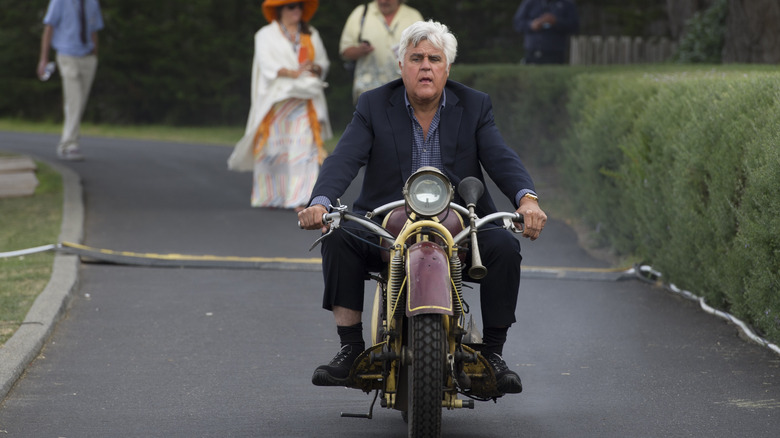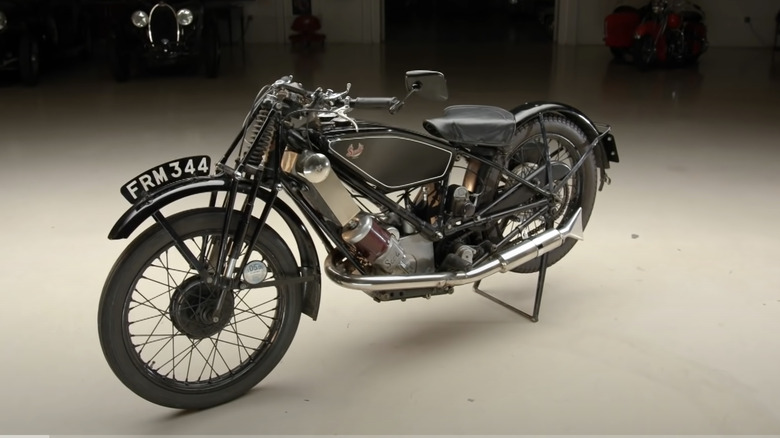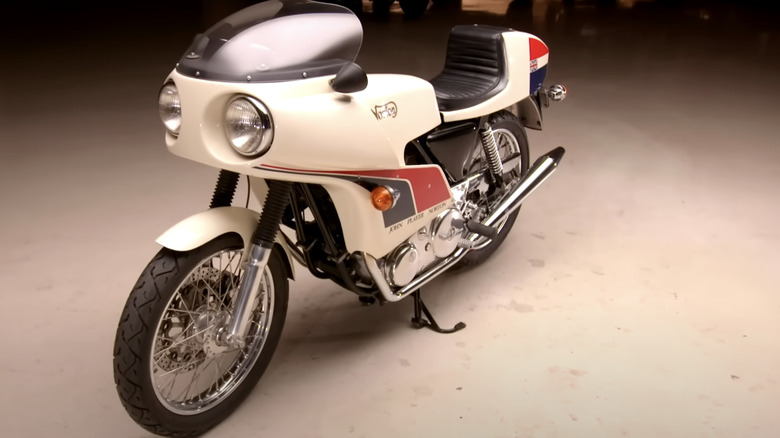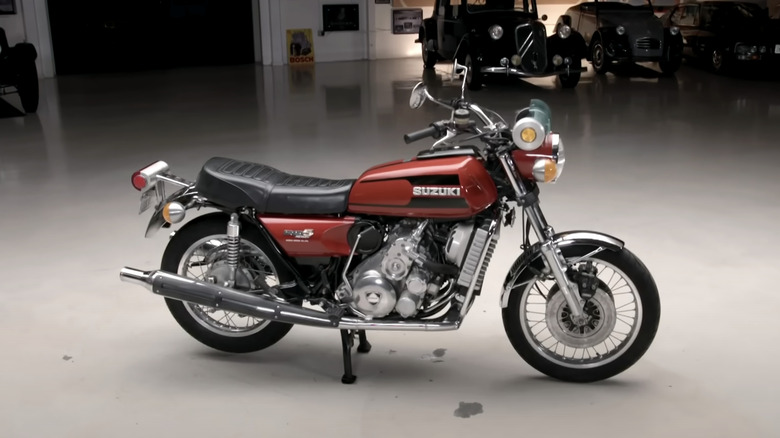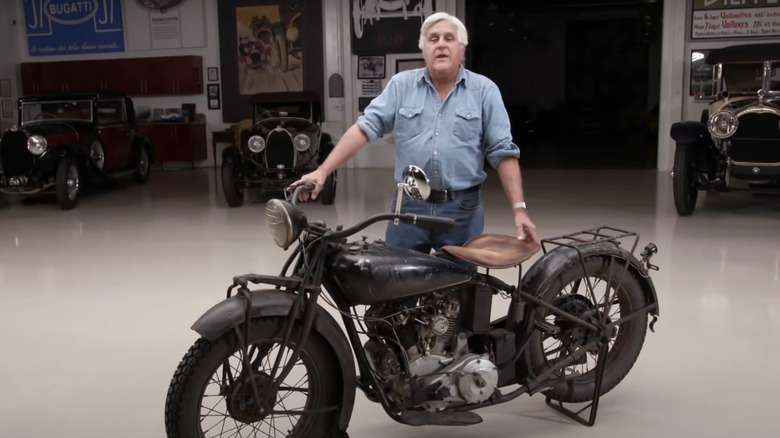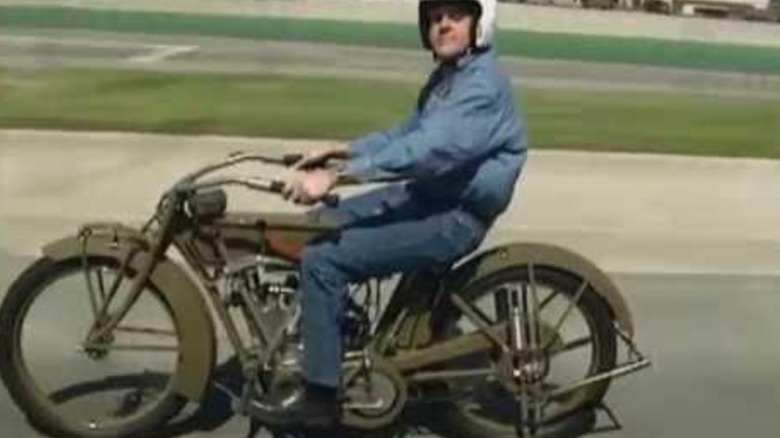5 Of The Coolest Motorcycles In Jay Leno's Collection
Jay Leno got his start in entertainment as a standup comedian in the Boston and Los Angeles areas and took over for Johnny Carson as host of "The Tonight Show" in 1992. He returned to host the show from 2010 until 2014. Between 1993 and 2005, Leno earned 11 Emmy nominations as a host or producer of "The Tonight Show," taking home one of the coveted gold statuettes in 1995.
Leno is also a noted gearhead, and his love of vintage and performance cars and motorcycles has earned him even more kudos from the Television Academy. His show "Jay Leno's Garage" began as a column in Popular Mechanics and was adapted into a web series that appeared on CNBC beginning in 2015. "Jay Leno's Garage" earned nine Emmy nominations between 2008 and 2018, including a win for outstanding special-class short-format non-fiction program in 2011. Guests on the program included "Home Improvement" star Tim Allen, racing legend and Formula 1 champion Mario Andretti, comedian Jerry Seinfeld, and two-time NASCAR Cup Series champion Joey Logano.
The show has also given Leno a chance to show off some of the remarkable motorcycles in his personal collection, along with those of some of his celebrity friends. Here are five of the most interesting bikes Leno has owned throughout the years, many of which have been featured on "Jay Leno's Garage."
1929 Scott Flying Squirrel
One of the oldest bikes in Leno's collection is a 1929 Scott Flying Squirrel, which is a replica of the race-winning model that company founder Alfred Angas Scott rode in that year's Isle of Man race. It's powered by a 596cc two-stroke engine with a water cooling system that works without the benefit of a mechanical pump.
Leno described the Flying Squirrel's engine cooling technology in the episode. "It uses something called thermo-siphoning," he explained." There's no water pump. What happens is the engine heats up [and] the hot water pushes the cold water forward, it goes through the radiator, and it recirculates that way."
As a racing replica, the bike has no headlight, taillight, or turn signals, but Leno managed to register it with the Department of Motor Vehicles, as the Flying Squirrel sports a California license plate and is shown zipping around on public roadways. "For a bike from the 1920s, the performance is amazing," Leno says. "I mean, it's a great bike to ride."
1974 Norton John Player Special
One of the bikes in Leno's collection is a British model he bought three years before he made his first standup appearance on "The Tonight Show." Leno purchased the 1974 Norton John Player Special brand new for $3,000 and said on the episode showcasing the bike that the bike stretched his budget at that juncture in his life. "I was kinda scraping the money together to buy it," he said. "I thought it was way too expensive at the time, but it's been worth it."
The John Norton Special has a broad, curved fairing with dual headlights and a seat that curves upward to provide a short backrest for the rider. It has an 822 cubic centimeter motor that generates 60 horsepower at 6,200 rpm. Leno's bike has an odd quirk: it has the rear brake pedal on the left and gear shift lever on the right as it was manufactured before September 1974. After that date, a law was passed mandating that U.S. market motorcycles have the rear brake pedal on the right side and shifter on the left.
1975 Suzuki RE5
Leno has another quirky motorcycle from the mid-1970s in his collection: a 1975 Suzuki RE5. At first glance, this bike looks like many other cafe racers of the era, but the RE5 was powered by a 497cc Wankel rotary engine that produced 62 horsepower. The bike has a striking design, and the engine is powerful for its size and delivers a smooth ride, but the RE5 wasn't a particularly strong seller. In the episode featuring his RE5, Leno explained that Honda first had to overcome stereotypes that Japanese-made bikes were poorly made, then fought the notion that the RE5 and its Wankel engine were just too weird for the American market.
"When this came out, people just thought, what?" Leno said. "It wasn't a torque monster like a Harley; it was just an incredibly smooth, wonderful riding motorcycle that handled pretty good."
"Try not to form an opinion until you ride one," he added. "It's very addictive. It's so smooth!"
1930 Indian Chief
Not every motorcycle in Leno's collection is a meticulously restored and carefully polished showpiece. The 1930 Indian Chief was given to him 40 years ago and had been in a wreck. Leno did the necessary mechanical repairs to get the bike's 1200cc V-twin engine humming again but left nearly all of the cosmetic blemishes in place. The Chief has a hard wooden seat, manual gear shift lever, and cargo rack atop the rear fender.
In the episode featuring the bike, Leno showed some of the damaged parts he had replaced and detailed the bike's controls, including the ignition timing control on the left handgrip and gas tank-mounted plunger that injected oil into the crankcase. The only modern accessory he added was a single rear-view mirror he mounted on the left handlebar. "It's a lot of fun to ride," he said. "It's a really unusual vintage machine. It takes some getting used to; it's not like a modern bike at all."
1918 Pope
One of the oldest and most interesting bikes in Leno's collection was never featured on "Jay Leno's Garage," but Leno did show it off on an episode of "My Classic Car" with Dennis Gage. The Pope had some controls that would appear odd to modern riders, like a left-side pedal that disengaged the clutch at the halfway point and activated the brakes at a full press. The rubber grips on both handlebars extended well past the end of the metal, hanging loosely for several inches. Leno explained to Gage that the dangling rubber was meant to make riding on the bumpy unpaved roads of the day more comfortable, as riders could lean back and grip the floppy ends and not have to hold on to vibrating metal handlebars.
He also showed Gage the cable-free twist-grip throttle mechanism that was integrated with and fully hidden inside the handlebars, along with some other advanced features. "This is a very, very expensive motorcycle," Leno said. "And very quick. Suspension front and rear, you have a hand clutch and a foot clutch, you got a three-speed transmission."
Leno even demonstrated the bike's elaborate starting process, which involved manually oiling the valves and priming the fuel system, after which the Pope started on the first kick of the lever.
